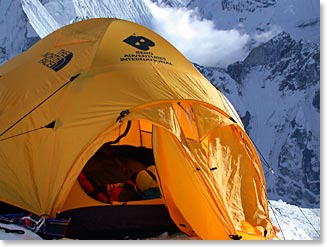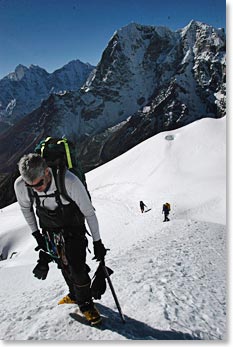
Climb Island Peak with Berg Adventures – FAQ
Here is where you will find answers to some of your questions about this expedition. If you do not find what you need here, please contact us at info@bergadventures.com.
Choose the specific question to link to your answer
- When is the monsoon (rainy) season in Nepal?
- What size backpack do I need?
- What are accommodations like in Kathmandu and while trekking and climbing?
- How much mountaineering experience do I need in order to climb Lobuche Peak?
- What about high-altitude acclimatization?
- Can we take showers during the trek? How do we clean ourselves?
- Could you give an example of a typical breakfast, lunch and dinner on the trek?
- What kind of camera should I bring?
- Can I recharge my iPod while on the mountain?
- Do you have access to radio communications for any emergency needs?
- Will I be able to check my email while trekking? How about my cell phone?
- 1. When is the monsoon (rainy) season in Nepal?

- The full monsoon season in Nepal is typically from mid-June to mid-September. July and August are the rainiest months.
- 2. What size backpack do I need?

- You will want a medium size rucksack (2500-3500 cubic inches or 40-55 liters) that can hold your layers of clothing for changing temperatures through the day. The porters and yaks who will carry your large duffel bags do not necessarily move faster than you do, and they almost always leave earlier in the morning than you will. The items you carry with you each day are largely what you need to be inactive, rather than what you need to hike in. For example, the jacket and hat you wear before the sun hits in the morning, the camera and the notebook you use to record your impressions during breaks. Do not follow advice to bring a smaller pack so that you will carry less. Packs that are slightly larger distribute the weight on your back better and are much easier to pack (especially with cold fingers!)
- 3. What are accommodations like in Kathmandu and while trekking and climbing?

- In Kathmandu, we stay at the Yak and Yeti, or another of Kathmandu's finest hotels. While trekking, we will be staying in beautiful lodges (some with private bathrooms!) throughout the duration of the entire trek. Our own cook staff will prepare all meals. For the climbing portion of the trip, we will use North Face 4 season VE-25 tents. All accommodations are double occupancy, but a single supplement is available – just ask!
- 4. How much mountaineering experience do I need in order to climb Lobuche Peak?

- Lobuche Peak is an alpine climb of moderate difficulty. You should have some experience walking with an ice axe, using crampons and doing self-arrests. Summit day will require a pre-dawn “alpine start” and your team will need to move efficiently on fixed lines and in teams across narrow ridges. The climb is spectacular! Your guides will offer a review of the necessary skills, but it is essential that you are familiar with the use of your climbing equipment (harness, crampons and ice axe) before the trip.
- 5. What about high-altitude acclimatization?

- You will notice on the itinerary that we take 11 days to walk from Lukla at 9,200ft/2,804m to base camp at 17,500ft/5,333m. At Namche and Pheriche, we take rest days to allow our bodies to adapt to higher altitudes. This schedule combined with a conscientious attitude, paying attention to our own bodies and to one another, has proven successful time after time.
- 6. Can we take showers during the trek? How do we clean ourselves?

- Hot showers with gravity fed water heated on gas stoves are available throughout the Khumbu. In the lower villages such as Namche, you will have solar heated showers in your private rooms in the lodges. As you go higher, washing facilities become simpler, but are always available. At the highest altitudes the showers are less likely to be used because outside temperatures are cold. Additionally, our Sherpa staff provides each person with a small basin of heated washing water each day. Warm washing water and soap for hands is also provided before each meal (and we insist you use it!).
- 7. Could you give an example of a typical breakfast, lunch and dinner on the trek?

- Our Sherpa cooks are masters at preparing a variety of healthy meals. They use almost exclusively fresh, whole ingredients. Produce and staples are purchased in the Kathmandu Valley and transported to the Khumbu via helicopter charter. Fresh meat and other supplements are purchased in Namche or along the way. Vegetarians rarely have complaints on Nepal trekking trips. Meat is served, but is always an addition to the main courses. Dal Bhatt (rice with lentils) and several other local Nepalese and Tibetan dishes are featured throughout our trek. They quite often become the favorites, but there are always other options at any meal where they are served.
- Typical day’s meals:
- Breakfast: Porridge, corn flakes, instant milk, fried eggs, toast with jam and butter, orange slices. Coffee, black tea and herbal tea, hot chocolate, tang.
- Lunch: Yak steak with chips (french fries), rice with lentils, cauliflower, toast with peanut butter and jam, cookies, fresh apples, hot drinks and tang.
- Afternoon Tea: Popcorn, saltine crackers with sliced cheese, hot drinks.
- Dinner: Soup, pizza, fresh green beans, mashed potatoes, banana fritters, hot drinks.
- 8. What kind of camera should I bring?

- Photography on a trip to Nepal can be especially rewarding. Plan to take pictures of people, especially close ups of smiles and expressions. You will not forget to take pictures of the grand scenery all around you, Everest, Ama Dablam, Pumori and the other great peaks. A camera that you are familiar with will be better than one you are learning to use. Small "point and shoot" cameras will always be used because they can stay handy in your pocket. However, inexpensive point and shoots can become unreliable in cold temperatures and dusty conditions.
- Digital cameras offer the flexibility and economy of working without film. Look for one that is simple, rugged and well-sealed. Many models of “point and shoot’ digital cameras tend to be quite fragile in the dust and cold of climbing on Lobuche. Look for a camera that is portable enough to be transported easily, yet not so small that controls will be difficult to work with gloves on or with cold fingers.
- Rugged SLR film cameras and higher quality Digital SLR’s offer the flexibility of interchangeable lenses and normally perform better in extreme conditions. Even though they are heavier, they are worth bringing if you have experience using them. Video camcorders are great because they allow for recording sounds and still shots as well as video. Do not leave your video camera or SLR camera at home just because you think they will be too heavy to carry to the summit.
- Regardless of what kind of cameras you bring, be sure to bring the charger for your batteries. You will be able to charge them at all our lodges. Also bring plenty of memory cards and / or film. Many people underestimate how many pictures they will take!
- 9. Can I recharge my iPod while on the mountain?

- It will be easy for you to recharge your iPod, cameras and other devices in the Khumbu. Some of the solar systems we use there will take the regular 110 type plugs which you already have. The most common adaptor plug that you need to use is the 220 type that has the two round prongs that are sold in stores in Canada as the type for “UK, Asia”.
- There are other three prong types that are used in Kathmandu, but we advise people not to worry about this. When you get to Kathmandu you can buy all the simple plug type adaptors that you need. They are sold in the hotel gift shops and at many stores and kiosks on the street in Kathmandu.
- 10. Do you have access to radio communications for any emergency needs?

- Our primary means of communication with Kathmandu and the rest of the world is our satellite phone. We will also carry radios and we will use cell phones from most locations on the trek and from higher elevations on Lobuche Peak
- 11. Will I be able to check my email while trekking? How about my cell phone?

- Internet is frequently available in the Khumbu, but it is not everywhere and it is not entirely reliable. You can expect to have internet access every couple of days during your trek. There will not be internet from Lobuche Base Camp or higher on the mountain however. Note that the internet can be slow and expensive as you get closer to Lobuche.
- The cell phone coverage in the Khumbu Valley is quite extensive now. More often than not you will have good cell coverage, although there will be dead spots. If you are planning to use your cell phone abroad, be sure to call your service provider to discuss international rate plans.

A cozy Berg Adventures tent

Climbing fixed lines on Lobuche

